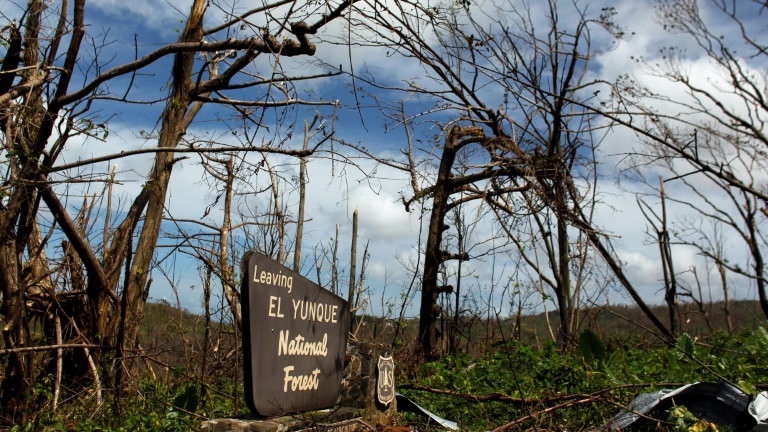
World
20:18, 06-Oct-2017
Puerto Rico's hurricane-wracked environment faces long recovery

Bees fly around, disoriented, searching for flowers to pollinate. The trees have no leaves and once-lush mountains are a mass of dry branches.
Hurricane Maria not only destroyed Puerto Rico's infrastructure, it also wreaked havoc on the environment, disrupting the island's entire ecosystem.
And experts say the road to recovery could be long.
"There is a lot of death, but eventually the order will be restored," said Ariel Lugo, an ecologist and director of the International Institute of Tropical Forestry, part of the US Forest Service in Puerto Rico.
"It will take ten years for everything to look good," he told AFP.
"It does not mean that everything will be fine, but everything will look good."
Two weeks after the hurricane, some trees are already beginning to sprout new leaves, a sign of the natural world's resilience.
But life has been thrown into turmoil for birds, insects and other organisms that depend on leaves and flowers for food and shelter. They struggle to find food and places to hide.
For predators, Puerto Rico is one big party these days.
The balance should start to be restored soon, according to Lugo.
"In the coming months there will be a rapid increase in plant growth and production of new leaves, which will revive many insects and thus begin to reorganize the forest little by little," he said.
According to Jeff Schlegelmilch, deputy director of the National Center for Disaster Preparedness in New York, the timing of recovery will vary by species.
"Some of the larger trees can take decades to come back while the smaller foliage cover might be back within a year or two," he told AFP.
"It could take decades or more before the forests are fully restored."
Puerto Rico is home to the El Yunque National Forest, the only tropical rainforest in the US national forest system.
It is one of the world's smallest (nearly 29,000 acres, 11,700 hectares) but most diverse tropical rainforests, serving as home to hundreds of plant and animal species.
Bad news for non-native species

Mangroves damaged when Hurricane Maria ripped through Puerto Rico. /AFP Photo
Mangroves damaged when Hurricane Maria ripped through Puerto Rico. /AFP Photo
A decapitated tree is not necessarily a dead tree, because the native flora and fauna of the Caribbean have adapted to hurricanes, and will bounce back, experts say.
For example, the towering tabonuco tree – known in English as candlewood – quickly regrows new branches.
Others have different mechanisms of survival in extreme conditions. The tall, narrow ausubo trees grow slow but strong, while the saw palm is prolific when it comes to producing new leaves.
"The hurricane is the natural selective force of the tropical forests of the Caribbean, and it is the hurricane who decides what lives on this island," said Lugo.
The ones that will have trouble are the non-native, or invasive species.
"All those plants and animals that we have brought from other parts of the world, which are not adapted to these conditions, are going to have a difficult time and may not survive," said Lugo.
"But what is indigenous or comes from places where there are winds and tides, will have no problem."
In the Las Cabezas de San Juan Nature Reserve, mangroves were lost and the water smells rotten.
But native trees like sea grapes, tamarind and almacigo – or turpentine trees – are "very resilient," said Carlos Morales of the Conservation Trust of Puerto Rico.
"From previous experience, we know that the reserve will begin to reforest, but it may take several years to become what it once was," added Morales.

Scientists fear that a lack of trees and foliage after Hurricane Maria hit Puerto Rico could make it easier for iguanas, which are considered a nuisance, to multiply. /AFP Photo
Scientists fear that a lack of trees and foliage after Hurricane Maria hit Puerto Rico could make it easier for iguanas, which are considered a nuisance, to multiply. /AFP Photo
One of the biggest concerns among scientists at the Fajardo reserve in the eastern part of the island is that the lack of trees and foliage will make it easier for iguanas to multiply.
These exotic reptiles are considered a nuisance in Puerto Rico because they have no predators.
"They are a very strong species. The lack of shade is a risk because they put the nests in the sand, in full sun," Morales said.
"Having less shade will increase the temperature of the soil, and that will mean they have more places to nest."
An overpopulation of iguanas could disrupt the ecosystem in the reserve.
Iguana mating season starts in February, and biologists can only hope that by then, trees will have regrown enough to produce some shade and keep their nesting under control.
"Everything will depend on how fast the forest recovers," Morales said.
13540km
Source(s): AFP

SITEMAP
Copyright © 2018 CGTN. Beijing ICP prepared NO.16065310-3
Copyright © 2018 CGTN. Beijing ICP prepared NO.16065310-3